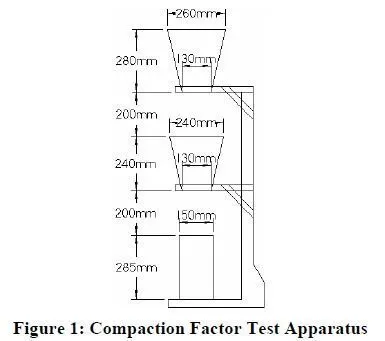The K-slump tester (Bartos 1992; Scanlon 1994; Ferraris 1999; Wong et al. 2000; US patent 3,863,494; Bartos, Sonebi, and Tamimi 2002) is a small device that can be inserted directly into a mass of fresh concrete to determine slump quickly. The test was developed by K.W. Nasser in the 1970s and is sometimes referred to as the Nasser probe.
The device consists of a hollow tube with slots and holes, as shown in Figure 2. The end with the pointed tip is inserted in the concrete. A flat plate at approximately mid-height of the tube indicates the proper depth of penetration of the device. A round plunger moves freely out the other end. The tube is inserted into the concrete with the plunger in the upper position to allow mortar from the concrete to enter the inside of the tube. After 60 seconds the plunger is lowered until it comes to rest on top of the mortar that has entered the tube. The depth of mortar in the tube, as read from the graduated scale on the plunger is taken as the K-slump. The plunger is again pulled to its upper position and the tube is removed from the concrete. After mortar is allowed to flow out of the tube, the plunger is lowered to rest on top of the remaining mortar in the tube. The reading on the graduated scale at this point is considered the workability, W.
The K-slump reading is linearly related to slump. The higher the workability reading, W, the greater is the workability and compactability of the mix. The difference between K and W is an indication of the susceptibility of a mixture to segregation.

The K-slump tester was standardized as ASTM C1362 in 1997 and is commercially available. A digital version of the tester has also been developed (US patent 5,437,181). The device is appropriate for medium and high workability concretes. The test cannot be modeled analytically and does not directly measure plastic viscosity, although the K and W terms provide greater information than just the slump. Since aggregates greater in size than the 3/8 inch slots cannot fit into the tube, the test does not fully measure the influence of aggregate on workability. Indeed, the scatter of the test results is large (Ferraris 1999).
Advantages:
The K-slump tester is simple and easier to use than the slump test. A direct result is available in approximately one minute.
The test can be performed on in-situ concrete.
The K and W terms provide more information than just the slump.
Disadvantages:
The test does not fully take into account the effects of coarse aggregates.
The test is static and is not appropriate for low slump concrete mixtures.
